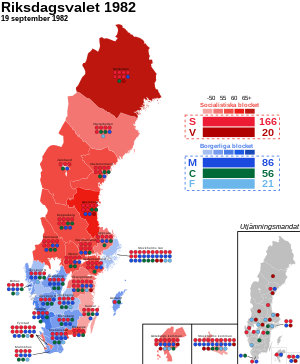Our website is made possible by displaying online advertisements to our visitors.
Please consider supporting us by disabling your ad blocker.
1982 Swedish general election
| |||||||||||||||||||||||||||||||||||||||||||||||||||||||||||||||||||||||||||
All 349 seats in the Riksdag 175 seats needed for a majority | |||||||||||||||||||||||||||||||||||||||||||||||||||||||||||||||||||||||||||
|---|---|---|---|---|---|---|---|---|---|---|---|---|---|---|---|---|---|---|---|---|---|---|---|---|---|---|---|---|---|---|---|---|---|---|---|---|---|---|---|---|---|---|---|---|---|---|---|---|---|---|---|---|---|---|---|---|---|---|---|---|---|---|---|---|---|---|---|---|---|---|---|---|---|---|---|
| |||||||||||||||||||||||||||||||||||||||||||||||||||||||||||||||||||||||||||
 Map of the election, showing the distribution of constituency and levelling seats, as well as the largest political bloc within each constituency. | |||||||||||||||||||||||||||||||||||||||||||||||||||||||||||||||||||||||||||
| |||||||||||||||||||||||||||||||||||||||||||||||||||||||||||||||||||||||||||
General elections were held in Sweden on 19 September 1982.[1] They saw the return of the Swedish Social Democratic Party to power after six years in opposition,[2] the longest period in opposition by the Social Democrats since the 1910s. The center-right coalition of Thorbjörn Fälldin had earlier suffered a loss upon the breakup of the government in 1981, the year before the election, when the rightist Moderate Party chose to withdraw from the government, protesting against the centrist tax policies of the Fälldin government. After regaining power, Social Democratic leader Olof Palme succeeded in being elected Prime Minister again, having earlier held power between 1969 and 1976.
The 2,533,250 votes for the Social Democrats is, in spite of a larger electorate, as of 2022 the highest number of people voting for a single party in Swedish electoral history, although the party had previously recorded higher percentage shares.
- ^ Dieter Nohlen & Philip Stöver (2010) Elections in Europe: A data handbook, p1858 ISBN 978-3-8329-5609-7
- ^ Ruin, Olof (1983). "The 1982 Swedish election: The re-emergence of an old pattern in a new situation". Electoral Studies. 2 (2): 166–171. doi:10.1016/0261-3794(83)90060-4. ISSN 0261-3794.
Previous Page Next Page
Eleccions legislatives sueques de 1982 Catalan Riksdagsvalget i Sverige 1982 Danish Wahl zum Schwedischen Reichstag 1982 German Elecciones generales de Suecia de 1982 Spanish Ruotsin valtiopäivävaalit 1982 Finnish Élections législatives suédoises de 1982 French Elezioni legislative in Svezia del 1982 Italian Zweedse parlementsverkiezingen 1982 Dutch Wybory parlamentarne w Szwecji w 1982 roku Polish Riksdagsvalet i Sverige 1982 Swedish







